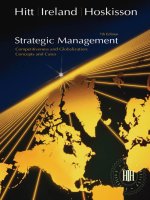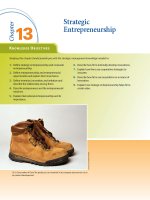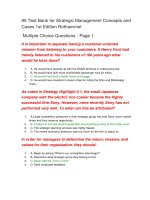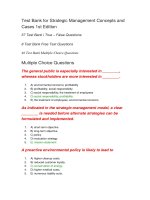International hospitality management concepts and cases
Bạn đang xem bản rút gọn của tài liệu. Xem và tải ngay bản đầy đủ của tài liệu tại đây (17.48 MB, 395 trang )
International Hospitality
Management
This page intentionally left blank
International Hospitality
Management
Concepts and Cases
Clarke and Chen
AMSTERDAM • BOSTON • HEIDELBERG • LONDON • NEW YORK • OXFORD
PARIS • SAN DIEGO • SAN FRANCISCO • SINGAPORE • SYDNEY • TOKYO
Butterworth-Heinemann is an imprint of Elsevier
Butterworth-Heinemann is an imprint of Elsevier
Linacre House, Jordan Hill, Oxford OX2 8DP
30 Corporate Drive, Suite 400, Burlington, MA 01803, USA
First Edition 2007
Copyright © 2007, Elsevier Ltd. All rights reserved
No part of this publication may be reproduced, stored in a retrieval system or
transmitted in any form or by any means electronic, mechanical, photocopying,
recording or otherwise without the prior written permission of the publisher
Permissions may be sought directly from Elsevier’s Science & Technology Rights
Department in Oxford, UK: phone (ϩ44) (0) 1865 843830; fax (ϩ44) (0) 1865 853333;
email: Alternatively you can submit your request online
by visiting the Elsevier web site at and
selecting Obtaining permission to use Elsevier material
Notice
No responsibility is assumed by the publisher for any injury and/or damage to persons
or property as a matter of products liability, negligence or otherwise, or from any use or
operation of any methods, products, instructions or ideas contained in the material herein.
British Library Cataloguing in Publication Data
A catalogue record for this book is available from the British Library
Library of Congress Cataloguing in Publication Data
A catalogue record for this book is available from the Library of Congress
ISBN: 978 0 7506 6675 6
Typeset by Charon Tec Ltd (A Macmillan Company), Chennai, India
www.charontec.com
Printed and bound by MPG Books Ltd, Bodmin, Cornwall, Great Britain
0708091011 10987654321
For information on all Butterworth-Heinemann publications
visit our web site at
Contents
Preface ix
Acknowledgements xi
1 Welcome: an introduction to international hospitality
management 1
Introduction 3
The roots of hospitality management 5
The context of international management in the
hospitality industry 8
Interpreting the concept of international management 10
Globalization and international hospitality management 14
Implications for hospitality and tourism 19
The structure of the book 21
Review questions 23
2 Cultures and the challenges of international hospitality
management 25
Introduction 27
Conclusion 51
Review questions 54
3 The international hospitality industry 55
Introduction 57
The elements of hospitality 57
International hospitality industry overview 59
The food service sector 61
Hotel food and beverage strategy: an evolving form 62
The accommodation sector 63
Chaining 64
Market segmentations 65
Level 1: The basic offer of shelter and sustenance 65
Level 2: Security 70
Level 3: Belonging 71
Level 4: Self-esteem status 75
Country resort hotels 76
Level 5: Self-actualization 77
Limitations to the framework 80
Small hotels, B&Bs and guest houses 81
Other accommodation sectors 82
Condo hotels 85
Main markets 87
The changing offer and market 88
Conclusion 90
Review questions 91
4 Exploring the international environment 93
Introduction 95
External environment analysis 95
Situational analysis 96
Environmental analysis 104
Key issues influencing the hotel industry 125
Summary 139
Conclusion 140
Review questions 140
5 International marketing 141
Introduction 143
The marketing concept 143
The concepts of marketing orientation 144
International market research and assessment 146
Global market segmentation 149
Demographic segmentation 149
Segmenting global markets by income and
population 149
Gender segmentation 151
Ethnic origin, religion and nationality 152
Global targeting 153
Marketing mix 155
Location and distribution channel 160
Promotion 162
Standardization of advertising programmes 163
International branding 164
Cultural sensitivity 164
Encoding 166
Selective media transmission 166
Decoding of feedback 166
Conclusion 173
Review questions 173
6 International hospitality market entry 175
Introduction 177
Types of foreign market entry strategies in the
hospitality industry 178
Non-investment management arrangements 184
Which method of entry should you use? 196
Conclusion 199
Review questions 199
7 Strategic planning and international hospitality
enterprises 201
Introduction 203
vi Contents
Strategic planning and global strategy 203
Mission and objectives 205
Environmental analysis 206
Industry analysis: forces influencing competition 209
Internal analysis 213
The Four Building Blocks of competitive advantage 214
Corporate value chain analysis 217
Sustainable competitive advantage in hypercompetitive
industry 224
Global competition and national competitive advantage 225
Portfolio analysis 234
Conclusion 236
Review questions 236
8 International human resources management: managing
diversity 237
Introduction 239
The formal and the informal organization 241
Centralization and decentralization 242
The informal organization 243
The management challenge 260
Review questions 262
9 Entrepreneurship and SMEs in the global market 263
Introduction 265
Conclusion 286
Review questions 287
10 Managing social responsibility in international
hospitality 289
Introduction 291
Right and wrong 291
Sense of place 297
Shades of green 298
Sustainable development 300
Social and cultural issues and stakeholder dialogue 301
Corporate sustainability 303
A question of responsibility 304
Definition 305
Economic 306
Environmental 306
What’s happening in the hotel industry? 309
The drivers for positive action 310
The future of sustainability 311
Social reporting 311
Sustainable business value 312
Conclusion 315
Review questions 316
viiContents
11 The analysis of international hospitality management 317
Introduction 319
Company overview 321
Company highlights on the theme parks 321
The operating environment 324
Global environment impacts 329
Strategy 330
Market entry 338
Disney’s future 343
Summary 350
Bibliography and references 353
Author Index 369
Subject Index 371
viii Contents
The development of hospitality and the issues with hospitality manage-
ment have been growing rapidly. It is an area of study and practice which
has emerged and established itself in Universities and Colleges around
the world. Alongside these courses, there has been an explosion in text
books and journals that explore the industry and the concerns with its
development. We are now adding to that collection with this book.
We believe that the study and the practice of hospitality management is a
significant area in contemporary lives and that it deserves serious consider-
ation. Moreover we believe that hospitality is an area of activity that is
sufficiently different to be considered separately from other aspects of
management. This differentiation does not mean that hospitality has to dis-
cover everything for itself but it does mean that we have to look carefully at
the translation of management studies into this field. There is a culture
identifiable within hospitality that requires general notions to be translated,
adapted and developed to fit the working conditions of the industry.
The focus of this book centres on the development of the hospitality
industry in the context of international markets and operations. These
also call into question the applicability of general notions as we believe
that local cultural conditions, organisational cultural contexts and the
processes of international management only make sense when these con-
ditions are recognised. We are against simplistic universalistic applica-
tions and hopefully demonstrate our reasoning in the following chapters.
Our thoughts have been shaped in many ways and over many years.
However, one simple message that comes through these experiences and
which hopefully is borne out in the book is that we can never take anything
for granted. Just because we are used to doing something in one particular
way does not make that the right way or the only way. We would urge you
to develop a critical approach to what you think you know and to question
where the basis for that knowledge comes from. This will help you to
explore your own cultural inheritance and question your expectations.
We began as you are now and would urge you to maximise your poten-
tial through your studies and your work in the industry. We share a won-
derful experience of studying for our PhDs with supervisors who
encouraged us to think and question our subjects. We owe them our
thanks and our gratitude for giving us far more than the formal qualifica-
tion. We hope that the approach taken in this book will help you develop
that approach also.
Preface
x Preface
We would like to recognise the contributions of some of our colleagues
including Prof. Stephen Ball, Peter Spencer, Sue Horner, Dave Egan,
Emma Martin, Mike Rimmington, Mike Mathews, John Swarbrooke,
Kitty Wang, Jenny Wade, Jenny Cockill, Zhao Haolu, Li Gang, and Huang
Rong. There are others, such as Stuart Hall and Raymond Williams, who
inspired the questioning of culture and many more in Universities in
Sheffield (both of them), North London, Milton Keynes, Derby,
Nottingham and Veszprém who have given us ideas and questions that
we continue to work with. Their friendship and their academic support
continue to be important to us.
Further more over the years we have worked with students at Diploma,
Undergraduate, Masters and PhD levels and learned more from these
encounters than we knew before. A particular mention is due to all the
Sheffield Hallam University Hospitality Business Management course
students because it was thinking through their needs that gave rise to this
specific project. It is a pleasure to see the growth of students and watch the
responses to seeds of ideas that are taken away and developed. It is a
source of great satisfaction to us to be involved in this process.
We have drawn widely from material that is available to any of you if
you know where to look. We have done our best to identify copyright
holders where ever possible, but particularly with some of the web
sources this proved difficult. We have also raised the question with some
who were not sure how to respond, so we apologise for causing alarm and
grateful for their help in resolving the concerns. If an unknowing use of
copyright material has been used please contact the authors, via the pub-
lisher, as every effort was made to contact the owners of the material. We
are grateful for their work as it adds richness to our arguments and we
would encourage them to keep up the work of monitoring and examining
our industry.
We would like to thank the people who have made this book possible. We
have benefited greatly from the supportive and critical dialogues with our
friends and colleagues, both in the industry and in Universities around
the world. We have met many people who gave us the belief that this was
an important book – and some who asked why we were doing it. All of
them kept us going. Special thanks has to go to our students, wherever we
found them, who made the book possible with their constant questioning
of what we thought we knew – they were and continue to be a constant
source of inspiration. We have had wonderful support from Sally North
and Francesca Ford at Elsevier and we hope that they feel their patience
was worthwhile. Our wives must have sympathized with them, surely
knowing how they felt and we are unbelievably grateful for their love and
understanding as the book interrupted what passes for normal in our
lives – thank you.
As usual we accept that we are indebted to many people for the sources
and contacts that produced this book, but they also know that all the
errors in the book are ours.
We dedicate this book to our children: Ruth, Jamie, Dan, Ben and Alex –
they are the future of international hospitality.
Acknowledgements
This page intentionally left blank
CHAPTER 1
Welcome: an
introduction to
international
hospitality
management
This page intentionally left blank
■ Introduction
As the illustration suggests, you are welcome! You are welcome to join us
on a rapid journey through the ways in which hospitality can be managed
within an international context. This book addresses a challenge that is
becoming increasingly important as we move through the 21st century,
After working through this chapter, you should be able to:
■ Follow the outline of the book and the logic of its construction
■ Review the international dimensions of hospitality management
■ Evaluate the nature of the host–guest relationship
■ Identify the positive and negative implications of globalization in hospitality
Chapter objectives
Figure 1.1
An example of a
multilingual
welcome – this key
holder was issued at
the InterContinental
in Budapest in 2006.
namely how can we attempt to manage hospitality internationally. There
have been many attempts and there are some which offer examples of
good practice but there are also many examples of failure and underper-
formance that point to a lack of understanding of or an inability to meet
the management challenge. We will draw on many examples in an attempt
to explore the issues which we believe underpin the operation of the hos-
pitality industry. For us we see the hospitality industry as the group of
organizations providing hospitality services and products to the public,
and we believe it has a very close relationship with the tourism industry.
You will be introduced to the traditional aspects of the industry, with
examples from hotels and restaurants, but we will also look at the ways in
which the industry has been changing (though we stop short at giving full
consideration to the underwater hotels and the space race!).
One of the tensions in the international study of any subject is how it is
constructed in different countries – this is very true for our field. In the
United Kingdom, tourism has overtaken hospitality as the centre of atten-
tion and research, with hospitality seen as a supporting sector. In the USA,
the major focus has tended to be on hospitality with tourism emerging as
a concern for the hospitality industry. In China, the phrase used is almost
always hospitality and tourism or tourism and hospitality. This most
clearly reflects our view that the two are interlinked and mutually depend-
ent. The hospitality and tourism industries together are the largest and
fastest growing industry in the world. The World Travel and Tourism
Council (www.wttc.org) estimate that hospitality and tourism as a global
economy are directly and indirectly responsible for 11% of gross domestic
product, 200 million jobs, 8% of total employment and 5.5 million new
jobs per year until 2010. This creates a wide range of management chal-
lenges and we will critically explore the developments within the indus-
try in the book.
This chapter will introduce the aspects of international hospitality man-
agement that we will address in the book and explain the rationale for
how we have divided it into 11 chapters, all of which deal with a major
element of international hospitality management.
Our position has grown out of our experiences of living and working in
international hospitality, both in our native countries and in other peo-
ple’s. This has sensitized us to the need to operate internationally in a way
that facilitates exchange and growth. We have seen ventures based on a
simple single culture being overwhelmed by the complexities of the world
we live in and that they had chosen to operate in. We will look further at
those issues by examining as a crucial example the introduction of the
Disney brand and the Disney concept into the European and Chinese
markets. These launches were not straightforward even for an organiza-
tion as well developed and powerful as Disney.
Our position is an unusual one within hospitality management and that
contributes to the challenging nature of this book. We have grown up in
the debates in leisure studies and tourism studies, which have seen those
areas move into critical debate. Jones (2004) has noted that hospitality
International Hospitality Management4
research is still lagging behind those fields. He identified the principal
schools of thought in hospitality as follows:
● Hospitality science model: Based on the natural and physical sciences
such as chemistry, biology and physics. Studies of this type include
research in diet, nutrition, ergonomics, equipment performance and
so on.
● Hospitality management school: This is largely based on empirical
and quantitative studies, often related to studies of hospitality market-
ing and consumption.
● Hospitality studies: This includes qualitative as well as quantitative
research.
● Hospitality relationship: This is a recent school of thought and sepa-
rate to, and distinct from, any management or industry association.
● Hospitality systems: Systems thinking accommodates both positivist
and normative research.
● Hospitality pragmatics: This is an all inclusive position dealing with
the realities of the industry.
We do not sit easily in any of these positions, deriving a concern for the
practical from the hospitality management school whilst being informed
by the concerns for the hospitality relationship. We hope this book brings
together the grounded elements of the case studies we provide with the
insights of the awareness of the dynamics of the relationships which are
central to our understanding of the hospitality industry and the distinc-
tive relationships which mark out our concern with the management of
international hospitality. We believe it is important to acknowledge our
roots in the different traditions in order to clarify where our perspective
comes from and how it shapes our analysis. We draw on the critical social
sciences, valuing a constructivist approach towards social research and
our analytical frameworks seek a holistic interpretation. We are pragmatic
in that we live, work, teach and holiday in the real world, but we are con-
scious of the importance of recognizing the power of the theoretical in
framing and explaining those real world situations.
■ The roots of hospitality
management
Hospitality is rooted in the relationships that develop between hosts and
guests, a dynamic which has existed since the first human societies emerged.
The early relationship was defined in terms of honour and respect within
a reciprocal framework. It was an honour for someone to visit you and, as
a good host, you treated your guest with respect and offered them com-
fort, security and entertainment. As a guest, you were aware of the hon-
our that the host was bestowing upon you during your stay by welcoming
5Introduction
you into the heart of their home and it was your duty to repay that kind-
ness with respect for your host’s values and customs.
Even when we look at the earliest origins of the hospitality industry we
find a mixture of journeys, both near and far, but they are all set within the
context of the honour of the host–guest relationship. In setting our book
within the context of this debate, we realize that we are visiting, and indeed
revisiting, a well trodden and yet still controversial corner of the hospitality
field. The couplet has been much used and some would argue misused over
the years in the study of tourism impacts and tourism development but the
critical dimensions feature less strongly in hospitality. We are seeking to use
it in the sense established in Smith’s seminal work (1977), in order to
explore the dynamics of international hospitality management.
We are adopting a holistic view of human society and a methodology
of cross-cultural analysis within this book, and we agree with Smith’s
emphasis on the need to unveil the internal processes of change inherent
in societies (see also Smith, 2001). She gives prominence to globalization
and the shrinking distances as communication and transportation bring
destinations closer and with it their connections to issues of time, authen-
ticity, identity and ethnicity.
Guest expectations
We also want to engage with the notion of guest within that range of
experiences.
Aramberri (2001) called his confrontational contribution The Hosts Should
Get Lost. He contends that the host–guest couplet is based around a pre-
modern formulation where there were three main features:
1 Protection extended by the host to the guest on the grounds of their
common humanity.
2 Reciprocity with the guest returning their host’s generosity.
3 Familial duties and obligation – with the guest becoming a part of the
host’s family and supported in the same ways.
Aramberri argues that the modern experience no longer contains these ele-
ments of exchange and obligation. His argument is based on the replace-
ment of the pre-modern experience of covenant by the contract form of
modern capitalist societies. “The point, however, is that the nonmaterial
reciprocity of the old covenant is gone and that no amount of mourning will
bring it back to life. If the covenant is gone, so are also the fuzzy codes of
mutual rights and duties that spelled its details. Now the main tie that binds
the contracting parties is the deliverance of services – commodities – on the
part of the hosts, and payment in cash for the tab they have been running on
behalf of the guests. In fact, the hosts are no longer hosts, just providers of
services, while the guests are no longer guests, just customers” (Aramberri,
2001: 746–747).
6 International Hospitality Management
The argument continues by suggesting that the hosts have deliberately
constructed the context for the commercialization of the contract because
of the opportunities to grow rich at the expense of the guests. We will
elaborate many of the points surrounding the contract relationship during
our discussions but rather than losing the host, we feel that they help to
redefine and recognize the role of the host in what we are calling interna-
tional hospitality management.
Because too much hospitality and tourism, or the wrong type of hospi-
tality and tourism, can despoil a community and marginalize the resi-
dents it is necessary to develop hospitality and tourism with care. Ideally,
hospitality and tourism development will permit hosts to cope with hos-
pitality and tourism by providing some cultural space for the guests while
simultaneously preserving other, more private space for the hosts. Smith
(2001) advocates the use of the four H’s – habitat, history, heritage and
handicrafts – as key elements in an ethnographic assessment of hospital-
ity and tourism. This book will show how these inform the practice and
analysis of international hospitality (Figure 1.2).
7Introduction
Figure 1.2
The four H’s
Figure 1.3
The hospitality
context
We would suggest that this can be re-presented within hospitality service
as shown in Figure 1.3.
Hospitality
Habitat Heritage HandicraftsHistory
Hospitality
Hospitality service
Host–Guest Contract
Habitat Heritage Handicrafts
Environment Traditions Culture Souvenirs
Service Offer
History
These elements help to translate the anthropological approaches into
the domain of the manager and the service provider that we will go on to
explore.
■ The context of international
management in the hospitality
industry
The hospitality offer takes many forms, the hotel room, the coffee or
should that be low-fat latté, the restaurant, the time share and so on. These
offers share a common starting point in the relationship between the
provider and the customer. However these relations are structured in
many ways, by the expectations of the organization and by the cultural
constraints of the hosts and the guests. If you do not believe that the offer
is structured try ordering one of the top of the range sports cars from a car
hire company if you are not 24 years old or hold a driving licence from a
different country!
When you explore the relationship between the hospitality provider
and the customer the constraints become more apparent. Moreover we
become accustomed to the usual practices that we grow up with. The
English have had a long and interesting history with the sale of alcohol,
growing accustomed to licensing laws that impose strong restrictions over
who can purchase alcohol, where and when. Travel outside those narrow
national boundaries and one of the surprises is the way that alcohol is
treated differently in other countries.
This simple example begins to raise the interest level in the interna-
tional dimensions of hospitality management. We would urge you to
open your imaginations and put aside the idea that there is a “normal”
that you should expect to underpin the hospitality offer as you travel
round the world or that you would impose on that offer.
We see the international dimension as more complicated than the sim-
ple trade between two countries. These commercial transactions can take
place with any commodity, subject to international trade agreements and
the willingness of the two parties to trade. In hospitality we are concerned
with a more complex transaction, one where the hosts and guests are
involved in the transactions at a variety of levels. You could argue that the
purchase of a “tea” is a simple purchase and mirrors the transaction of any
international trade. We would argue that it is far more complex than that
and involves the host and the guest in a more complex relationship. What
do we mean by tea? Also refer to Plate 1.
This book is the product of many sessions drinking tea in the United
Kingdom, but it was not a traditional English breakfast tea, served in
china cups with milk and sugar. Mostly it was a Chinese tea, drunk from
mugs with nothing but the tea to interfere with the taste. Quite what the
neighbours would have said if they had known remains the subject of
8 International Hospitality Management
speculation. In Hungary we serve tea but with lemon not milk, but we do
not go into the Turkish tradition of sugaring everything despite, or
because of, the years of Turkish occupation. The offer of tea is therefore
culturally a complex one, drawing on the specific cultural patterns of the
hosts and may well challenge the conventional expectations of the guest
(Plate 2).
9Introduction
Plate 1
Source: Bettys
Harrogate. Bettys is a
well-loved Yorkshire
institution, having a
long history of serving
fine quality tea, coffee
and cakes
Plate 2
An Asian tea house.
Source: Author’s
photograph. This
shows the entrance
to an Asian tea
house, which has
traditionally been
more important to
the culture than
coffee
We believe that such tensions are at the heart of managing international
hospitality. How the specific and the different can be presented to the
guest/customer as an exciting and satisfying experience, without reduc-
ing everything to a standardized commodity is at the heart of the chal-
lenge faced by the industry.
We believe that we need this book because the hospitality industry has
moved into a position where any and all of its transactions could be set
within this international context. We are aware from our experiences of
hosting both in our native cultures and within foreign cultures of the chal-
lenges that these hospitality offers construct and that overcoming these
interconnecting difficulties is never as simple as it first appears. Challenges
and opportunities exist for the new generation of hospitality managers,
even for a local hotel, where there is a frequent need to think outside the
narrow confines of a local cultural construction and meet the expectations
of an international market. This may not only be presented in the demands
of foreign travellers but also in the worldwide influences that have come to
work on the expectations of the local clients as well. It has been argued that
the most famous café in the world is not a Starbucks or a McDonald’s but
“Central Perk”, the café that kept the cast of characters from “Friends” fed
and watered throughout the 10 series of the worldwide smash hit American
television comedy. “Friends” influenced people in many ways – styles of
dress, haircuts, names for their children and even what to ask for in a café!
This worked both in terms of the menu and the style and décor of the space
itself. Starbucks and their like influenced these trends but did not necessar-
ily control them as they were also influenced by them. The cultural pressure
derived from the media, and the huge success of the series, contributed to
the growth of the internationalization of guests’ expectations about hospi-
tality. It was not an intended consequence of the series but the effect was felt
nevertheless.
What we mean by international must therefore be seen in this broader
and more culturally informed context. Rather than being contained in the
trade between two countries, what we see as defining the international is
the exchange of cultural values and expectations that underpin the host–
guest relationship within any hospitality exchange. For us the focus is
cultural rather than commercial and it is the cultural dynamic which is
constantly changing and shifting that lies at the heart of the management
challenge as we perceive it.
■ Interpreting the concept
of international management
Most management texts assume that the concept of management is self-
explanatory, it is after all about managing. We feel that the concept deserves
slightly more consideration as our perspective will suggest that the ways
in which management is interpreted is itself culturally significant and
introduces a change into the operating environment of the organization.
10 International Hospitality Management
One suggestion is that management is all about ensuring that the organ-
ization makes a profit – and certainly does not make a loss! In most cases,
survival is not a preferred option as managers are required to show greater
returns on the company’s investment (Figure 1.4).
11Introduction
Profit
Survival
Loss
Figure 1.4
The peaks of
management
This is a view of management that is based on the concept of the advanced
capitalist firm, operating with a division of labour that separates the man-
agement of the organization from what happens within it. We do not see
management as merely the mindless pursuit of profit as we see managers
having a more open role in hospitality organizations. Whilst the concern for
the bottom line and profit will be a factor, we believe that managers have a
crucial role in the delivery of service quality and are vital to the internal and
external image of the organization. Therefore we would suggest that the
manager is involved in a process which involves taking the organization
from where they are now, the current state, to where they want to be, the
desired future state. The desired future state will encapsulate a more
rounded view of the organization than simply its profitability (Figure 1.5).
Management
Current
state
Desired
future
state
Figure 1.5
The management
journey
Let us consider what the process of management involves and therefore
what is required of the manager. We believe that there are six components
of the managerial role:
1 Strategy: Determining the direction of the organization and establish-
ing the ways in which it will be able to achieve its objectives.
2 Structure: Considering how the organization is patterned and ensur-
ing that the structure facilitates the delivery of the objectives.
3 People: The management process will involve dealing with people
inside and outside the organization, with a variety of roles from devel-
opment to discipline.
4 Operating environment: Coming to understand the internal and exter-
nal forces that influence the organization and the impacts they may
have on the future performance of the organization.
5 The market(s) and marketing: How will the organization select and
present itself to existing and potential customers.
6 Social responsibility: Demonstrating both a private and social profit
for the company.
These are the elements that we see constituting what a manager should
do – but we recognize that not all managers will do all of them all of time.
However we do see an increased awareness about what is involved in
these six areas as helpful in developing sensitive and informed managers
for the hospitality organizations of the future. We would also stress that
this management process does not operate in a vacuum. All organizations
are set within the context of cultures and given that the focus of this book
is on international management, we would have to address the role of
international cultures in shaping the opportunities for organizations. This
can be seen both positively and negatively, with some aspects of the cul-
tural environment encouraging development – those we have termed
enabling forces, whilst others are likely to present obstacles to challenge
the development of the organization – which we have identified as resist-
ing forces. We would also say that the same analysis holds for the culture
of the organization itself or the management culture (Figure 1.6). Parts of
this will be open to the challenge of international management but others
will be more resistant. We would therefore ask you to share our model of
how this international hospitality management is constructed.
There is one danger with this model, and indeed with all such models
of management, which is that it presents an analytical framework for the
study of international hospitality management but the very drawing of
the model denies the interrelationships between the elements. Our model
does not intend to prioritize any of the six elements in the centre, they
could be presented in any order and the model would be just as coherent.
Nor do we intend the sets of forces to be seen as separate from the ele-
ments contained by them. We see this as a dynamic relationship between
the cultural forces, from both the organizational management and inter-
national dimensions, and the knowledge, skills and competences required
to deliver the practice of management. Our conception of the model is one
of analytical separation but we recognize that the separation is required
for presentational purposes but in practice we would see a myriad of
12 International Hospitality Management









